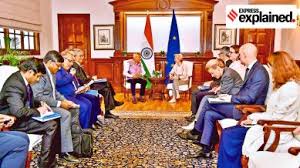India-EU Strategic Partnership

- 01 Mar 2025
In News:
The recent visit of European Commission President Ursula von der Leyen to India, marked a significant recalibration in India-EU relations. Amid global geopolitical flux—characterized by U.S.-Europe divergences, China’s assertiveness, and disrupted supply chains—India and the EU are deepening cooperation in trade, technology, climate, and security. This partnership is crucial for regional stability and shaping a multipolar, rules-based global order.
Strategic and Economic Dimensions
- Trade and Investment:The EU is India’s largest trading partner, accounting for 12.2% of India’s total trade in 2023. Bilateral goods trade reached $135 billion (FY 2023–24), and services trade stood at $53 billion. The EU is the second-largest source of FDI into India ($117.4 billion since 2000), while Indian FDI to the EU was $40 billion. Free Trade Agreement (FTA) talks, revived in 2021, aim to resolve tariff and regulatory barriers in sectors like automobiles, dairy, pharma, and IT services.
- Technology and Digital Cooperation:The India-EU Trade and Technology Council (TTC), launched in 2022, promotes collaboration in semiconductors, AI, clean energy, and resilient supply chains. Key developments include MoUs on semiconductor R&D and high-performance computing. Challenges remain, particularly around EU data adequacy under GDPR, which affects Indian digital exporters.
- Green Transition and Energy Security:The EU-India Clean Energy and Climate Partnership focuses on renewable energy, smart grids, and sustainable cities. A €1 billion European Investment Bank fund supports green hydrogen projects. India’s participation in European Hydrogen Week 2024 signals growing collaboration in clean energy. Initiatives like SWITCH-Asia promote sustainable consumption and circular economy practices.
- Maritime and Defense Cooperation:Under the ESIWA framework, India and the EU are expanding maritime security ties. The EU has stationed a liaison officer at India’s Information Fusion Centre (Gurugram), and the first joint naval exercise in the Gulf of Guinea (2023) emphasized Indo-Pacific cooperation. However, defense ties remain limited due to India's stronger military relationships with Russia and the U.S.
Institutional and Societal Ties
India-EU relations date back to 1962 and were elevated to a Strategic Partnership in 2004. The Roadmap to 2025, adopted in 2020, prioritizes digital transformation, climate action, and multilateralism. The TTC’s recent meetings reaffirm commitment to tech and trade collaboration.
People-to-people ties are strengthening. Indians received over 20% of EU Blue Cards (2023–24). Over 6,000 Indian students have benefitted from Erasmus scholarships, and 2,700 researchers from Marie Sk?odowska-Curie Actions.
Key Challenges
- Stalled FTA Talks over tariffs and market access.
- Regulatory barriers under SPS and TBT norms.
- Data governance divergence due to lack of EU data adequacy for India.
- Foreign policy misalignments, especially over Russia-Ukraine.
- Fragmented defense engagement due to EU’s limited commitment.
Way Forward
India and the EU must resolve FTA hurdles, negotiate a data-sharing framework, align Indo-Pacific strategies, and invest in alternative supply chains via IMEC. Enhanced cooperation in green tech, cybersecurity, and digital infrastructure is key. India must also reform its regulatory landscape to attract EU tech and manufacturing investments.
Conclusion
India-EU ties are entering a transformative phase. Anchored in shared democratic values and strategic interests, the partnership can promote multipolarity, sustainable development, and a resilient global governance architecture.
